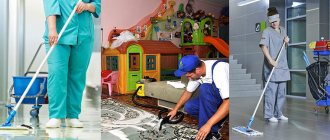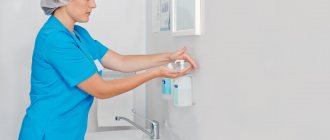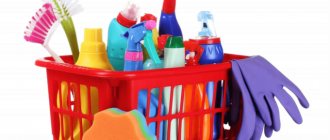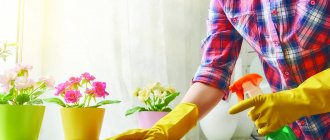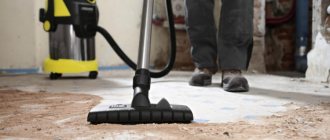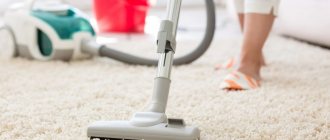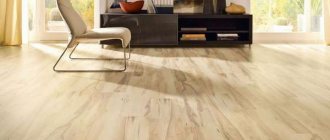What you need to know about the cleaning equipment room
The bright colors of the equipment will not allow you to confuse it.
The cleaning equipment room is a small separate room that is equipped in residential, office and industrial places. All equipment that is used during cleaning is stored, cleaned and dried there - from rags and cleaning products to vacuum cleaners and other equipment. This room is also called a mop room.
Some SanPiN requirements apply to the room and things stored in it:
- All tools and products used during cleaning should be marked in different colors according to the location used. This is due to the fact that different buckets, rags and mops are used in each room. In order not to confuse the equipment and not start cleaning the kitchen with a toilet mop, it is necessary to apply decals. Instead of individual colors, the inventory is labeled, for example, “for floors.”
- All cleaning equipment should be stored in one separate place, including household chemicals and washing machines for washing rags and attachments;
- Before cleaning equipment, it must be washed, disinfected and dried. It must be stored in a special order - on racks and in carts with free access.
Use and storage of cleaning equipment
The following rules are prescribed for the storage and use of cleaning equipment, especially in healthcare organizations:
- Clear markings on all items according to the direction of use (for example, “floor” and “above the floor”, “kitchen”, “hygiene”, etc.)
- Use strictly for its intended purpose (the mop from the sick unit cannot be used in the cafeteria)
- A developed system for sample disinfection is required (cleaning, drying, placing in solution, irradiation)
- Storage in cabinets in a special order (carts and racks with easy access may be used)
In other organizations, inventory should be stored identically, i.e. There should be a mop for stairs and corridors, a mop for toilets and separate items for cleaning cafes and food units of the organization.
Tool accounting at the enterprise
How should the cleaning equipment room be equipped?
Here it is important to understand whether such a premises is categorized according to clause 5.1.6 of document SP 4.13130. 2009 or not. The area and fire and explosion safety standards for such objects are different.
It is necessary to answer the question whether the cleaning equipment room is a pantry or storage area in essence or whether it belongs to the category of other premises of the company and institutions.
Next, you need to study the Technical Regulations on Fire Safety in order to equip everything correctly. But many people believe that a warehouse and a storage room are two different things. That's why they don't categorize the cleaning equipment room.
Fire safety does not suffer at all due to this approach. Of course, if we are not talking about a special storage room in an industrial building or public complex.
There is already a special staff serving the area. These are storekeepers, packers, merchandisers. In an ordinary room for cleaners, it is necessary to provide:
- Trays and sinks with drain
- Bottom taps for water intake
- Settling siphons
- A set of rags for different needs
- Watering taps in sinks
All these standards are prescribed taking into account the area of the premises being cleaned.
PLEASE NOTE: if the storage room is located in an elevator shaft or occupies a place in a fire barrier, it must be protected with a fire-resistant protective block.
In general, as a general rule, the installation of a fire-resistant structure is dictated primarily by the purpose of the room for cleaning equipment. The area of such a room is also important, and not just its equipment.
This is a room category of B4 standards. This means that the main thing is that there must be cold and hot water here, but the presence or absence of a fireproof inlet block will be determined by other characteristics.
IMPORTANT: if the pantry is located in an ordinary residential building, but there are fire-hazardous cleaning products in it, there must be a fire-resistant protective door.
Cleaning equipment room design standards
Before you start equipping a mop room, you need to create a room design. It takes into account all design standards and sanitary and fire safety standards specific to this room.
How to calculate dimensions
The area of the room is calculated based on the area of the entire floor: for every 100 sq. meters of area should be allocated 0.8 sq. meters of storage room. Minimum size - 2 square meters. meters. If the floor area is less than 400 sq. meters, one storage room can be used on 2 floors.
What should a mop house be equipped with?
The pantry can accommodate a washing machine and dryers
The room must be equipped with the following:
- A sewer pipe with a settling siphon: dirty water will be drained into it. These can be drains, pallets (for example, from showers measuring 0.8 * 0.8 or 0.9 * 0.9 meters) or the base of a toilet;
- Hot and cold water supply, it should be supplied to sinks and a low tap through which water is drawn into buckets;
- Watering taps in sinks;
- Washing machine: it is not necessary, but if necessary, regularly washing a large number of rags and attachments will help save energy and time;
- Heated towel rail for rags and towels: it can be electric or water;
- Good ventilation: when designing it, specialists must calculate the air exchange rate;
- Shelves, cabinets, containers and other containers for storing equipment. When choosing, you should focus on a specific situation: if only napkins and other dry products will be stored in the pantry, you can install open high shelves; for storing toxic products, you should choose closed cabinets. It is better to allocate a separate place for household devices (vacuum cleaners, etc.), and put small items in drawers.
Important! There should be a bathroom next to the room. Its area is not regulated by law, so it can be quite tiny.
Classification of cleaning equipment
There are different approaches to solving this issue. This is explained by the variety of options for use: cleaning equipment for medical institutions, for cleaning the street from snow or ordinary garbage, for cleaning residential premises, bathrooms, etc.
The list of cleaning equipment, labeling, storage, rules of use are contained in the SANPIN regulations.
Marking
Devices must be marked with symbols indicating their purpose:
Buckets: UB - for washing toilets.- For floors - for cleaning relevant surfaces in service and passenger areas.
- For sofas - for cleaning walls, balustrades, benches, sofas in passenger rooms.
- UB - for sweeping toilets.
- Cleaning Rags: The red flap on the corner is for cleaning toilets.
- The green patch on the corner is for cleaning service/passenger rooms.
- Flannel - no markings. This device is designed for processing benches, walls, balustrades, sofas.
Designations are applied in different ways: on buckets - with paint, on brushes - with paint or burned on a handle, on rags - sewn on.
Marking cleaning equipment according to SANPIN is a mandatory condition for industrial premises, schools, kindergartens, catering establishments, etc.
Color coding
This step is very important for zoning cleaning equipment, which is required to prevent cross-contamination and bacterial contamination during cleaning. Among the most common is the Quattro marking, according to which the gradation is carried out as follows:
red - for high-risk areas (for example: bathrooms, bathroom floors). If we are talking about a restaurant kitchen or canteen, then this color indicates equipment for cleaning a meat shop. In medical institutions, such equipment is used to treat sanitary facilities, rooms with dirty linen and waste;- green - wiping kitchen tables, counters in bars, cleaning industrial premises and vegetable shops. If we are talking about healthcare, then we mean devices for cleaning treatment rooms and dressing rooms;
- yellow - as a rule, used to mark equipment for working with other surfaces;
- blue - for areas with the lowest risk (for example, in the guest sector). In medicine, it is customary to designate instruments for corridors, wards, and resident rooms. In public catering, this shade indicates use in a fish shop. In addition, such equipment is actively used for wiping furniture.
Requirements for a cleaning equipment storage room
Despite the simplicity of the premises, the Cleaning Equipment Storeroom has strict requirements, but depending on the footage, they are changeable. In particular, on a floor of 100 square meters, the toilet storage area should be at least 0.8 square meters.
A floor area of about 400 m2 requires a storage room on two floors at once. The closet turns out to be an adjacent type, and the need for explosion and fire safety and good ventilation becomes mandatory. In this case, specialists calculate the frequency of air exchange.
There are also a number of requirements for finishing work:
- moisture resistance. Finishing is carried out with water-repellent materials in a layer of 2.1 meters. The best option would be ceramic tiles coated with a layer of oil paint;
- waterproofing the floor covering. The layer of waterproofing materials should be at least 30 cm, and the edges must rise to the wall. This type of insulation work can be found in bathrooms;
- fire protection door. This requirement is especially important in rooms with an area of 11 square meters or more - the door requires fire safety category B;
- presence of a sewer pipe. This could be a drain, a sump, or a toilet going into the sewer. During cleaning, dirty water is poured into these drains. Drains are considered the least convenient method, so they are often replaced with pallets or toilet bases. It is allowed to use shower trays with a size of 0.9 * 0.9 meters or 0.8 * 0.8 meters;
- equipment for industrial cleaning in the building. For mechanical cleaning, you will need to install several vacuum cleaners, which are more convenient to bring in through sliding doors;
- a sign on the door stating the purpose of the room and the prohibition on the presence of outsiders. A fire door will prevent open fire from spreading throughout the building, even if there is a fire or explosion inside. The cleaning equipment storeroom always contains a number of explosive and caustic chemical solutions and substances, the improper storage of which can harm the health and life of people;
- fire-resistant entrance block if the pantry is located in an elevator shaft or fire barrier. Only a professional team that has a special license to carry out this type of activity can install a structure that is resistant to open flames indoors.
Map of cleaning premises of health care facilities
Routine cleaning is carried out according to the priority of the premises and in the required sequence. The correct disinfection of premises and, ultimately, compliance with the sanitary and epidemiological regime in health care facilities depends on compliance with this algorithm.
Cleaning sequence
- Premises of operating rooms, maternity rooms, treatment rooms, examination rooms
- Clean linen
- Chambers
- Staff rooms, staff room
- Corridor
- Dirty laundry
- Sanitary facilities
- Room for temporary collection and storage of class B waste
Multiplicity (frequency) of cleaning
Halls, corridors, elevator halls, staircases, auxiliary rooms
The following should be carried out once a day:
- wet cleaning of hard floors
- removal of dust from all horizontal surfaces: desks, chairs, shelves, cabinets, folders, office equipment (excluding medical equipment and computers), telephones, etc.
- mechanized or manual floor cleaning in the lobby, halls, corridors
- removal of dust from door frames, window sills, railings, baseboards, radiators and heating pipes (to which there is access), electrical fittings (switches, sockets, boxes, etc.), fire and utility hatch boxes, door panels, closers, tables and other horizontal surfaces
- removing dirt from walls, glass surfaces, railings
- wet cleaning of stairs
- removal of contamination from all horizontal surfaces within reach
- cleaning the technical service room
- dry cleaning of dirt mats in summer, dry and wet cleaning (collection of water) of dirt mats in winter
- emptying and cleaning and disinfection of bins
- collection, disposal and transportation of waste to specially designated areas
- wet cleaning of clean linen
Main premises
The following should be cleaned twice a day:
- chambers
- procedural
- examination rooms
- dirty laundry
The following should be cleaned more than twice a day:
- maternity rooms - three times a day
- operating rooms – after each operation
- buffet, distribution areas, canteens - after each food distribution
Other rooms and surfaces
Weekly:
- cleaning the security room on the first floor
- cleaning upholstered furniture
- wet wiping and disinfection of telephone sets
- cleaning glass partitions
- cleaning ventilation grilles
Read also: Conducting general cleaning in medical institutions
Toilets
Conducted daily:
- wet floor cleaning
- washing and disinfecting all sinks, toilets, etc., both inside and out
- washing seats on both sides
- emptying and cleaning (if necessary) paper collection containers, removing waste to specially designated areas
How to choose the right door to the inventory storage room?
Whatever the area of the storage room for gardening or cleaning equipment, the door should be made of steel. As a rule, a single-leaf model with different levels of fire resistance is installed. The external finish can be powder coated or GF-021 enamel-primer. This door contains three reliable components:
- filler basalt slab, non-flammable type;
- seal against the penetration of cold smoke and hot steam;
- thermally active strip for maximum door tightness.
Inventory accounting
Accessories will be included in fixed assets only if their use period exceeds a year. This rule is contained in subparagraph “b” of paragraph 4 of the Accounting Rules (PBU). Inventory may be recorded as part of the materials. However, this is permissible only within a certain limit. This limit may be set by the policy of the enterprise itself. However, it cannot be more than 40 thousand rubles. The maximum volume of the limit is established by paragraph 4 of clause 5 of the PBU.
If the useful life does not exceed a year, records are kept in the list of materials. For this purpose, according to paragraphs 2 and 4 of the PBU, the score is 10-9. The introduction of objects is reflected in accounting in a standard manner.
Question: An enterprise purchased inventory and household supplies for its new division, but due to the fact that the division did not start operations, it was forced to sell them. How to reflect this transaction in accounting? View answer
How to store equipment at the dacha?
At the dacha, a storage room for cleaning equipment is also made, but tools, gardening equipment, equipment, and seasonal items are stored inside. In this case, the pantry is made so that it does not take up much space on the site without losing useful space inside. It is necessary to arrange a storage room for garden tools in the country carefully so as not to clutter the room.
It is not recommended to store broken things or rusty equipment, old cans of paint, varnishes and other unnecessary things. Free space inside the country storage room will help you better navigate it and perform some work.
Storage rules
Rules for storing cleaning equipment:
- Only equipment that has clear markings is sent for storage - if it has become illegible, it needs to be updated;
- It is prohibited to use equipment for other purposes;
- all cleaning equipment should be stored in special cabinets - mops and brushes are placed vertically, mounted on special holders;
- do not store brushes, buckets and rags that are used for cleaning in different rooms together;
- Only disinfected buckets, mops, etc. are put away for storage;
- you cannot leave inventory for storage anywhere other than a special room;
- disinfectants and detergents must be stored in the manufacturer’s packaging, with the label intact;
- sanitary rooms should be equipped with sinks, they should provide places for storing garbage and materials that have become unusable; it is desirable to have outlets with low taps for collecting water in buckets.
Compliance with storage rules is a prerequisite for working with equipment in medical institutions. Failure to comply with them may cause the spread of infections.
All working personnel must be familiarized with the rules for working with cleaning devices.
Arrangement of SBP is the duty of the employer
Description of sanitary and hygienic standards and requirements
Preventive, health and hygiene measures that ensure the safety of employees during work when using production facilities are regulated by law (Part 1, Article 24 of Federal Law No. 52) and SanPiN standards. State policy in the field of labor protection determines the regulations for supplying workers with safety equipment (personal and collective). In accordance with Art. 210 of the Labor Code of the Russian Federation, the head of the organization, at the expense of the enterprise, must provide employees with:
- sanitary facilities;
- comfortable service;
- therapeutic and prophylactic devices;
- medical equipment (under Articles 212, 223 of the Labor Code).
Medical office
According to labor safety standards, the head of the enterprise, in addition to specialized premises, must arrange:
- canteens;
- medical room for emergency care and prevention;
- devices for supplying drinking resources;
- ramps for disabled access.
The composition of ancillary and household buildings is designed at the stage of construction of an industrial complex.
Requirements for auxiliary premises
Sanitary and hygienic passport of a carcinogenic organization
The UPS space and type of operation are determined by the total number of employees and working conditions. The amount of places must match the number of employees per half square. m per person. Changing rooms in production with insufficiently serious pollution are dressing rooms for storing everyday and work clothes and washrooms with 1 tap for 7 people. Most industrial organizations require separate changing rooms for home and work clothes. Sanitary facilities are not only showers, washbasins and toilets, they also include storage areas for dirty and clean uniforms.
Enterprises also need to install special sheds for drying and removing dust from overalls, and equipment for cleaning work shoes. For workers at sites with heavy pollution, rooms are set up for health-improving physiotherapeutic procedures: light therapy, inhalations.
Dining room
Drying of workwear is usually done directly in cabinets using heated air or installing air heaters in them. The best option is to supply heat to the bottom and remove it from the top.
Documentary support
When releasing tools from warehouses, it is necessary to issue a demand invoice. The document is executed according to form No. M-11. The requirement was established by the State Statistics Committee of the Russian Federation in 1997 (resolution No. 71a). The document indicates, in accordance with Order of the Ministry of Finance of the Russian Federation No. 119n, the following information:
- The name of the department that requested the inventory.
- Account number for accounting costs for supporting the activities of the unit.
Accessories can be transferred to an intermediate unit (this concept refers to accounting departments and purchasing departments). In such a situation, it is difficult to determine the exact amount of inventory that will be used by the departments. The way out is to draw up reports as supplies are used up. The acts are drawn up in free form, but they must contain the following information:
- department name;
- number of supplied accessories;
- price;
- the purposes for which the object is requested.
Based on the drawn up acts, objects are written off as expenses. The procedure was approved by MU No. 119n.
Accounting in a simplified form
Companies classified as small businesses can conduct accounting in a simplified form. The release of objects involves a connection with the account “Production expenses” or account 44 “Expenses for sales”. The accountant must issue a demand invoice. It is performed according to form No. M-11. At the same time, posting is carried out: DT 25, 26, 44 KT 10-9 (release of objects).
Writing off accessories involves setting a price at which they will be written off. The operation is performed from a count of 10-9. The cost is determined based on the following methods:
- At the cost of one piece.
- FIFO.
- Average cost.
The methods are approved by paragraph 16 of the PBU. The method used must be reflected in the accounting policy. This is needed for accounting purposes. This provision was introduced by paragraph 73 of MU No. 119n.
When reflecting, security control is used. This is due to the fact that when a facility is put into operation, costs are transferred into costs.
Only objects whose service life exceeds a year and are registered in the list of materials are controlled.
The law does not stipulate the procedure for accounting for objects transferred to use. Therefore, it is installed by the enterprise itself. To track the movement of objects across departments, the following documents are used:
- Statement.
- Off-balance sheet accounting.
The chosen option for maintaining papers is fixed in the company policy. Documentation is maintained by an employee with financial responsibility. The Plan does not have an individual off-balance sheet account, and therefore it is created independently. For example, an enterprise opens account 013 “Households. accessories".
When transferring inventory to use, the following transactions are made:
- DT 25, 26, 44 KT 10-9 (release of objects from warehouse).
- DT 013 (accounting of objects).
- KT 013 (inventory write-off).
When objects are disposed of, it is necessary to create a write-off report. Its form is not established by law. Its independent approval is allowed. The procedure for recording related expenses is determined depending on the taxation system adopted by the enterprise.
Regulations for shower rooms in companies
Register of sanitary and epidemiological conclusions of Rospotrebnadzor
The number of shower cabins in production is determined by the sanitary parameters of production based on 3 cabins per shift of 5-10 people. According to the rules, showers and changing rooms should not be located near the external walls of buildings to avoid condensation. In all sanitary premises the following is required:
- lining walls and partitions with waterproof materials to a height of 3 m;
- painting the ceiling with moisture-resistant paint;
- covering the floor with waterproof tiles.
Shower
Requirements for shower facilities at an enterprise correspond to the nature of the products manufactured and working conditions.
Washbasins with cold and hot water and baths for washing feet are usually organized in separate rooms, but it is acceptable in dressing rooms.
Additional Information. If heavy contamination occurs during work, hand washing facilities with special means are provided at the rate of 1 unit per 40 workers.
Toilets in production are designed in accordance with sanitary standards within 75 m from places of work, on the territory of a plant or factory - up to 150 m. There should be 1 toilet for 30 men or 15 women, and a personal cubicle for 100 people. If more than 15 women work in a shift, it is recommended to organize a hygiene room for them in the structure of the cabins next to the restrooms.
Sanitary standards for the construction and reconstruction of utility and office premises
Requirements for the technological development of industrial enterprise projects are determined in clause 7.13 of GOST, established by Rosstandart in 2015. The Resolution of the Chief State Sanitary Doctor (2010) lists the types of auxiliary premises at newly built and reconstructed facilities, and instructions for their technical reconstruction. The standards apply to any form of ownership and departmental affiliation and are specified in the order for administrative and domestic buildings.
The same document defines the rules for warehouses intended for separate storage of clean and contaminated workwear. At enterprises with heavy pollution, the following premises are provided:
- for processing (dust removal, neutralization) of workwear;
- for disinfection of half masks and respirators;
- for cleaning dust filters;
- for washing, drying and repairing shoes and clothes.
Marking of cleaning equipment according to SanPiN: sample
Copyright: Lori's photo bank According to SanPiN requirements, all cleaning equipment must be marked with certain colors, taking into account the types of cleaning work and the functional purpose of the premises. In addition, it must be stored in .
At the same time, a color coding scheme should be placed in the inventory storage area. The marking of cleaning equipment according to SanPiN, a sample of which can be found below, is mandatory in medical institutions, industrial premises, schools, kindergartens, catering establishments and other institutions. Its main purpose is to prevent cross-contamination and pathogen contamination during cleaning.
This is achieved by accurately distributing inventory into separate zones. Today, the main regulatory document regulating the procedure for applying markings to cleaning equipment, storage and rules for using equipment is the Resolution of the Chief State Sanitary Doctor of the Russian Federation dated May 18, 2010 No. 58 (ed.
dated June 10, 2016) “On approval of SanPiN 2.1.3.2630-10.”
The document was developed for medical institutions, but in terms of the sanitary maintenance of equipment, its provisions are applicable to any area.
There are no clear instructions in SanPiN as to what color of marking should be used in a particular zone. It only states the requirement that all cleaning equipment must be clearly marked or color coded (clause 11.5 of SanPiN). Organizations have the right to independently develop a color coding system, with the following colors most often used: red, blue, yellow, green.
An old song in a new way
The easiest way to get acquainted with this concept is in public catering establishments or in offices. It is in such institutions that, in rooms far from view, lurk inconspicuous doors on which hangs a sign reading “Mop Room.” What kind of strange room is this, many visitors are probably wondering, although in reality there is nothing interesting there. This is a typical service storage.
However, too many concepts may fall under the traditional designation of office space, because a server room, a toilet, and a warehouse can be called rooms designed to solve official needs. Well, specifically in the mop room it is customary to store a variety of cleaning equipment. In our country, a sign with the inscription “Household” was usually attached to the doors of such a place. inventory,” but now for many it is associated with remnants of the Soviet past, so they found an alternative to it, borrowing a new name for the closet from the British. In English, “mop” is mop, and it is from this word that the new name for the utility room originated.
Marking
Labeling of cleaning equipment in medical institutions is mandatory. It is necessary to prevent the spread of infection during cleaning.
Marking can be applied in the following way:
- If a medical institution uses equipment without color gradation, then marks are applied to it using indelible paint. Buckets, basins and other containers are marked on the outside.
- Reusable cloth napkins and rags are labeled by sewing small pieces of fabric in the desired color. Flannel napkins are not marked.
- Markings may be burned into brush handles.
- Buckets and brushes for cleaning in the toilet are marked with the letters “UB”, for other rooms - “For floors”, for the surfaces of sofas and seats - “For sofas”, for processing equipment - “For equipment”.
There is also a “Quad” classification that divides inventory by color:
- To process sanitary and utility rooms where garbage and dirty laundry are stored, red equipment is used. This indicates that it can only be used to service premises with significant bacterial contamination of surfaces.
- Green equipment is used to care for furniture, treat treatment tables, and dressing stations. This color indicates that the requirements for cleanliness at such facilities are extremely high.
- To treat rooms with low sanitary requirements, equipment marked in blue is used.
- The rest of the furniture, surfaces and products are washed with equipment marked in yellow.
Blue equipment is used for processing staff rooms, canteens, halls and other public areas.
About primary sources
However, do not confuse the awkward design of two sticks, knocked together in the shape of the letter “T” and a rag made from an old T-shirt with special equipment for washing floors. A mop is a device consisting of a long handle with a brush attached to the lower end. This is either a bundle of soft strands made of cotton and connected together on a threaded washer, or a flat cover with short, thick loops that fits onto the mop using pockets.
This equipment is convenient and practical to use. Its body is a device made of plastic and a metal rod. Mops designed for flat mops have a floating head, which improves access to problem areas such as corners, niches and corners. The pads themselves come in three widths:
- 40 cm;
- 50 cm;
- 80 cm.
They are made from cotton or microfiber. There are also models with inserts made of hard material; they are designed for washing surfaces with depressions or bulges.
List of equipment for cleaning premises
The modern market is oversaturated with such equipment. In hardware stores you can find a huge range of cleaning products for every taste. In such a variety, it’s easy to get confused and acquire unnecessary things, so it’s worth thoroughly understanding this issue.
All kinds of cleaning equipment are used to clean various surfaces and rooms. This includes:
- cleaning cart;
- mop;
- rags;
- bucket;
- brush;
- broom;
- scraper;
- pad;
- screed
It is worth noting that professionals use several variants of the same name (for example, brushes with long and short handles). This is done to optimize the cleaning process as much as possible.
It is worth considering seasonality. So, in winter you will need special shovels to remove snow outside.
It is not enough to simply purchase a certain set of tools. You still need to use them correctly, in accordance with official requirements. That is why it is customary to divide inventory depending on the tasks that are solved with its help.
Closet with a secret
Many readers may have doubts about the need for such a room as a home mop room. What is this - a necessity or a whim? And is it necessary to allocate scarce square meters for its organization? Everyone will decide this issue for themselves, but we note that it is not at all necessary to “house” cleaning equipment in a separate room.
You can organize a small space to compactly place cleaning products and tools. This is useful from a safety point of view, and also significantly saves space, because mops and buckets collected in one place will not get underfoot in the bathroom, on the balcony and in the kitchen.
Requirements
In a medical facility, it is impossible to refuse cleaning equipment. However, unlike classic cleaning equipment, it is subject to special requirements developed by SanPin:
Equipment must be marked. There is our own equipment for the treatment of sanitary facilities, halls, wards and office premises.- All cleaning equipment is stored in separate rooms, in special cabinets.
- Once cleaning is completed, all equipment should be washed, disinfected and dried.
- Products for reusable use are washed using disinfectant solutions.
- Cleaning workers must wear special clothing and be given rubber gloves, masks, caps, aprons, etc.
- Different equipment is provided for washing walls and floors.
- Only professional equipment can be used for cleaning in medical institutions.
- All cleaning devices must be made of materials that are not destroyed upon contact with disinfectant, alkaline and acidic solutions.
- Mechanized cleaning is possible only with the use of professional equipment with a reduced noise level. Vacuum cleaners and floor washing machines are used only when cleaning in public areas. They are not used in dressing rooms, operating rooms or wards for bedridden patients.
- Napkins for wiping surfaces should be made of materials that quickly absorb and release moisture, and are also not afraid of washing at a temperature of 95 degrees.
- Disinfection carried out for the purpose of prevention is carried out using steam generators.
Where is it found?
There is a mop room everywhere, it’s just not in every place that it bears that name. The first back rooms were given this name by fast food restaurants that operate as franchises (McDonald's, KFS, etc.).
Nowadays it has spread to enterprises with a different field of activity and is found everywhere, perhaps due to the fact that it gives a very clear (albeit rather unusual) definition of utility rooms, where everything for cleaning the premises is stored. In fact, this is a good practice, because enterprises that have skimped on organizing a special place for various household chemicals and cleaning and washing equipment put all this stuff wherever they need it. Often these are toilets, storage areas for goods, including food, a dressing room or a service kitchen.
Category of storage rooms in residential and public buildings
Letter from JSC TIZHGP “Krasnodargrazhdanproekt” “on the category of fire hazard of storage rooms in residential and public buildings” No. 3568/3 dated December 28, 2010.
Due to the inconsistency of the current regulatory documents regarding the determination of the fire hazard of storerooms in residential and public buildings, we ask you to provide clarification on this issue.
Currently, the requirements for the arrangement of storage rooms for cleaning equipment in residential and public buildings are contained in the following regulatory documents:
1. According to clause 4.16 of SNiP 31-01-2003 “Residential multi-apartment buildings” and clause 4.38 of SNiP 31-06-2009 “Public buildings and structures”, buildings should provide storage rooms for cleaning equipment with an approximate area of 4. The pantry room must be equipped with hot and cold water supply.
The composition of a standard set of equipment located in the pantry (fire load) is a mop, bucket, rag, gloves (hard, flammable materials and substances), 1 - 2 kg of cleaning and detergents (solid, non-flammable materials and substances).
The functional fire hazard of cleaning equipment storage rooms is considered in two ways by the standards:
1. On the one hand, according to clause 5.1.6 SP 4.13130.2009 and clause 2.25 of Table 7 SNiP 2.09.04-87 “Administrative and domestic buildings”, the storage room for cleaning equipment is a sanitary premises, and, accordingly, the definition Explosion and fire hazard categories for the premises are not required.
Kbk for insurance premiums
2. On the other hand, “storeroom”, according to the semantic content of the word, refers to premises for storage purposes, and, according to Article 27 of Federal Law-123, its category for explosion and fire hazard should be determined within categories B1-B4.
2.1 According to clause 25 of NPB 103-03 and adj. B SP 12.13130.2009 the area where the fire load is placed, with actually small values, is empirically accepted as at least 10.
According to Appendix 4 of the manual to NPB 105-95, we determine the value of the lower calorific value of a mop and a floor rag:
— cotton in bales with a lower calorific value of 16.75 MJ*. Approximate weight 0.5 kg.
— wood with a lower calorific value of 13.8 MJ*. Approximate weight 0.5 kg.
The fire load will be equal to Q=ΣGx =0.5 x 16.75+
The specific fire load will be g=Q/S=15.28/10=1.52 MJ*.
Thus exaggerating the fire and explosion threat from the premises many times over, it is necessary to assign the premises category -B4 (fire hazard).
If there is a shortage of space, the standards do not prohibit the establishment of a storage area for cleaning equipment in the bathroom. Thus, category B-4 should be assigned to the san/node.
2.2According to clause 4 of the Federal Law-123, clause 5.2 of SP 12.13130.2009, clause 5 of NPB 105-03, the categories of premises are determined by sequentially checking the belonging of the premises from the most dangerous (highest) A to the least dangerous (lowest) D.
The next category, after B, is G- (moderate fire hazard) - non-flammable substances in a molten state with the release of radiant heat, sparks and flames.
Thus, an absurd conclusion arises: a storage room for cleaning equipment with a fire load calculated in paragraph 2.1 is much more dangerous than a steelmaking shop.
2.3 According to Appendix 6 of the manual on the use of NPB 105-95 “. pending appropriate changes to building codes and regulations. » to premises B4, the requirements established by the current SNiP for category D should be applied. “Technical Regulations on Fire Safety Requirements” 123-FZ, which came into force in 2009, does not contain such explanations.
3. According to clause 5.3 of SNiP 31-01-2003, a storage room should be provided in apartments provided to citizens taking into account social norms.
Following the logic, these storerooms also belong to warehouses and, accordingly, they should also be assigned category B-4 (or B-3, due to the greater fire load) and, according to clause 5.1.10 of SP 4.13130.2009, storerooms must be separated from other rooms by fire partitions:
with the installation of fire doors with EI15 and EI30, respectively.
In connection with the above, we ask you to answer the following questions:
Which group of premises according to their functional purpose should include storerooms for cleaning equipment in public and residential buildings - household premises or warehouses?
Should it be considered that with the release of 123-FZ, the clarification given in Appendix 6 of the manual on the application of NPB 105-95 (see paragraph 2.3 of the letter) has lost force?
Should storage rooms built into apartments be considered storage facilities (F5.2), built into housing (F1.3)?
Response from the Federal State Institution VNIIPO EMERCOM of Russia “on the categorization of premises of functional fire hazard class F.5” No. 13-5-02/283 dated January 26, 2011.
The premises indicated in your letter (clauses 1.3) in accordance with Article 32 of Federal Law No. 123-F3 belong to the functional fire hazard class F. 5. In accordance with clause 1.1 of SP 12.13130.2009 for premises of class F. 5 must categories of explosion and fire hazards should be determined.
The provisions of the joint Instructive Letter of the Ministry of Construction of Russia dated December 25, 1995 No. 01-601/13 and the Main Directorate of State Traffic Safety of the Ministry of Internal Affairs of Russia dated December 18, 1995 No. 20/2.2/2449, given in Appendix 6 - “Manuals for the use of NPB 105-95”, apply only to those existing SNiPs that have not been amended accordingly for categories of premises B4, and do not contradict the requirements of Federal Law No. 123 and codes of practice.
Arrangement of the working area of the country pantry
At the dacha, furniture is often repaired, indoor flowers are replanted, and tools and garden equipment are also repaired. To do this, you need a work surface with a stable base.
It is recommended to place several drawers or shelves under the tabletop for things that should be at hand while working. Wooden boxes are attached to the walls near the table. You can place containers or containers with small items, crayons, pencils, scissors, accessories, etc. on them.
Suspension systems
Garden equipment and tools are best stored hanging. Hanging shelves around the entire perimeter will free up additional space on the floor. Containers and cabinets are hung near the ceiling, in which you can fit a lot of necessary and non-format things. On these shelves you can store boxes or small buckets, gardening tools, bags or watering cans, bundles of grass, onions or garlic.
Skates, sleds, skis and other recreational items are best stored in mezzanine-type cabinets. By installing ceiling hooks for bicycles, sleds or garden furniture, you can save additional usable space in your closet.
Shelving
The order in the equipped pantry of cleaning equipment will be constant if you equip the room with modular or stationary type shelving. Having a large number of sections, such structures distribute many necessary and useful things that are present in any household.
Canned food, building materials, equipment and utensils are placed in one rack, and food, baskets of cereals and other food can be placed on the shelves of open storage systems along the walls. It is important to leave enough space in the passage so that there are no obstacles to the passage through the room.
Unusual ideas for storing cleaning equipment
To clean a house or cottage, care for a garden and other premises, you have to perform many different jobs. The simplicity and safety of cleaning depends on the quality of the equipment or materials used, which is why it is important to monitor the quality of the equipment and its condition. Experts recommend avoiding the use of rusty and damaged items. Any item deteriorates not only when used, but also when stored incorrectly, so you need to allocate its own place for each item.
For example, sometimes a wall-mounted container is made from boards, the compartments of which vary in width and depth. The sharp parts of the tools should not protrude beyond the box, and each item must be carefully secured.
Set of cleaning tools and accessories
The list of tools and devices for cleaning depends on the focus of the medical institution, its area, traffic flow and more.
The classic set looks like this:
- Surface cleaning and disinfection products. They can be liquid, paste-like, granular. All substances must dissolve well. It is possible to use only low-toxic compounds without a pungent odor or irritating effect on mucous membranes or skin.
- Sponges and rags.
- Buckets, containers for treating walls, mops, brushes, screeds, mops.
- Container for detergents and disinfectants.
- Garbage bags.
- For mechanized cleaning: vacuum cleaners, floor washing machines, steam generators.
- Cleaning trolleys.
A medical facility must have all the necessary equipment for both wet and dry cleaning.
If rags and buckets are used for daily activities, then more equipment is required for general cleaning. Its implementation can be simplified with the help of mechanized equipment.
